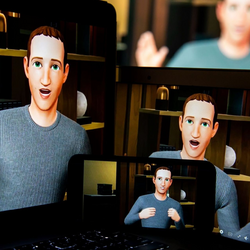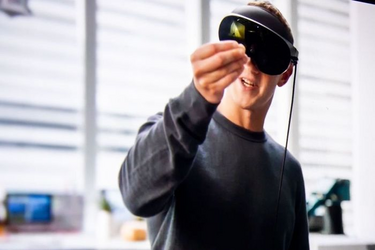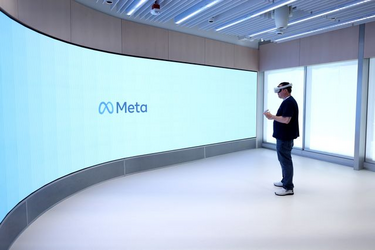
An avatar of Meta CEO Mark Zuckerberg spoke earlier this week at an event promoting the company’s metaverse offerings. MICHAEL NAGLE/BLOOMBERG NEWS
By Jeff Horwitz, Salvador Rodriguez and Meghan Bobrowsky
Oct. 15, 2022 5:30 am ET
Nearly a year after Mark Zuckerberg rebranded Facebook as Meta Platforms Inc. in a bet-the-company move on the metaverse, internal documents show the transition grappling with glitchy technology, uninterested users and a lack of clarity about what it will take to succeed.
While Mr. Zuckerberg has said the transition to a more immersive online experience will take years, the company’s flagship metaverse offering for consumers, Horizon Worlds, is falling short of internal performance expectations.
Meta initially set a goal of reaching 500,000 monthly active users for Horizon Worlds by the end of this year, but in recent weeks revised that figure to 280,000. The current tally is less than 200,000, the documents show.
Most visitors to Horizon generally don’t return to the app after the first month, and the user base has steadily declined since the spring, according to the documents, which include internal memos from employees.
By comparison, Meta’s social-media products, including Facebook, Instagram and WhatsApp, together attract more than 3.5 billion average monthly users—a figure equivalent to almost half the world’s population. Horizon is currently reaching less than the population of Sioux Falls, S.D.
Horizon is designed to be a sprawling collection of interactive virtual spaces, or worlds, in which users appearing as avatars can shop, party and work. Yet there are rarely any girls in the Hot Girl Summer Rooftop Pool Party, and in Murder Village there is often no one to kill. Even the company’s showcase worlds, such as Questy’s, a virtual arcade featured in a Super Bowl commercial earlier this year, are mostly barren of users.
According to internal statistics, only 9% of worlds built by creators are ever visited by at least 50 people. Most are never visited at all.
“An empty world is a sad world,” said one document summarizing the company’s efforts to herd users toward venues where they would encounter others.

Questy’s, a virtual arcade featured in a Super Bowl commercial, hasn’t drawn many users.
A Meta spokesman said the company’s metaverse efforts were always intended to be a multiyear project, and that it is making improvements, including many designed to keep users safe. He said it is easy to be a cynic about the metaverse, but that the company continues to believe it is the future of computing.
Horizon is accessible through Meta’s Quest virtual-reality headsets, which offer a range of games and activities. Quest retention rates, meaning continued use by owners, have dropped in each of the past three years, the documents show. More than half of Quest headsets—the entry model costs about $400—aren’t in use six months after they are purchased, according to people familiar with the data.
In a survey of Horizon users, Meta researchers said users reported that they couldn’t find metaverse worlds they liked and couldn’t find other people to hang out with. Other complaints included that “people do not look real” and that the avatars don’t have legs.
The researchers noted that the survey included only 514 people because the available pool of users to survey is “small and precious.”
The number of Horizon users online at the same time, known as concurrency, trails far behind both the socially focused upstart VR Chat and Second Life, the pioneering cyberworld that was launched in 2003, said people familiar with the matter.
To deal with persistent bugs and user complaints, Meta last month quietly put Horizon on “lockdown,” meaning it is pausing the launch of new features until it improves the current user experience, the documents show.
The company’s metaverse challenges coincide with business issues on other fronts, including increasing pressure on its digital-ad business and competition from social-media app TikTok. Meta shares are down more than 60% in the past year. The company has lost more than $700 billion in market value since the peak in September 2021.
At a metaverse-themed event on Tuesday, Mr. Zuckerberg unveiled a new virtual-reality headset called the Quest Pro, which is aimed at making it easier for architects, engineers and designers to work in the metaverse. With a $1,500 price tag, it isn’t aimed at average consumers, but Mr. Zuckerberg said it would set a new standard for metaverse technology. He also promised that avatars would soon get legs in Horizon.

On Tuesday, Mr. Zuckerberg unveiled the Quest Pro, a virtual-reality headset designed for professionals to use in the workplace.
PHOTO: MICHAEL NAGLE/BLOOMBERG NEWS
Meta has said it plans to expand the experience to more people with a web version of Horizon for mobile devices and computers. It had said it planned to launch that version this year, but when asked on Tuesday if that was still the case, a spokesman said Meta didn’t have any launch dates to disclose.
Other tech giants, including Microsoft Corp. and Apple Inc., are developing products on the belief that the metaverse is the next digital frontier.
Rolf Illenberger, chief executive of virtual-reality software company VRdirect, said in an interview that Horizon has issues to address, but asked critics to have patience and recognize that the industry is still developing. “We’re trying to land on the moon, and people are complaining that the coffee machine’s not working,” he said.
The metaverse was supposed to offer Meta a fresh start as it faces other business pressures and negative publicity. The new strategy was announced weeks after the leak of thousands of pages of internal records documenting the business struggles and societal downsides of the company’s social-media products, documented in a Wall Street Journal series called The Facebook Files.
The company’s announcement that it was pivoting to focus on the metaverse kicked off a corporate rush to stake claims on the new format. Companies hired “chief metaverse officers.” Hucksters sold metaverse real estate. Luxury brands Balenciaga and Prada joined with Meta to promote digital clothes, and even liquor makers such as Absolut Vodka opened bars and distilleries in the metaverse.
In a Meta memo titled “AR, VR or the Metaverse: Which is the next billion-user platform?”, Dare Obasanjo, lead product manager for Horizon and the metaverse platform, wrote: “You will have freedom of identity and expression and can hang out, work, play, learn, shop, create and more in an endless number of virtual worlds that could not exist in real life.”
While Mr. Obasanjo said that the metaverse—which is accessible not just by virtual reality headsets but PCs, mobile phones and augmented-reality products such as smart glasses—has a better shot at mass adoption than augmented or virtual reality products, Meta hasn’t yet pulled together a strategy for investing in it.
“Currently it’s unclear where the metaverse fits in the investment framework,“ he wrote in the memo. ”We are overdue for a reassessment of how we invest and allocate resources.”
Meta has canceled or delayed early metaverse-related products, and current and former employees said there is disagreement inside the company about whether Horizon should be focused on games or, as is Mr. Zuckerberg’s preference, social connection.
In a memo last month announcing the lockdown of Horizon, which was first reported by the tech publication the Verge, Meta’s Metaverse Vice President Vishal Shah wrote that the core thesis for the metaverse has proven to be strong. But stability issues and complaints from creators, he said, are “making it too hard for our community to enjoy the magic of Horizon.”
Part of the problem, he said, is that Meta employees aren’t using the product enough themselves. “The simple truth is, if we don’t love it, how can we expect our users to love it?” he wrote.

A Meta employee prepares to demonstrate a videogame that uses a virtual-reality headset.
PHOTO: JUSTIN SULLIVAN/GETTY IMAGES
Among the persistent complaints from early adopters and testers, according to the documents, are that users have trouble adjusting to the technology, and that other users behave badly.
On a recent night, a female Journal reporter visited one of Horizon’s most popular virtual worlds, the Soapstone Comedy Club. It had about 20 users in it, all appearing as avatars. When the reporter introduced herself and tried to conduct an interview with a small group, one user replied: “You can report on me, baby.” The same user then asked her to expose herself.
One user who was flirting with a woman in the crowd was interrupted by what appeared to be his real-life girlfriend yelling obscenities at him in the background.
According to the documents, men outnumber women in Horizon by two to one. One safety feature Horizon has introduced is an option for users to create the equivalent of a 4-foot personal boundary for their avatars to deter unwanted physical contact.
The next day, a male Journal reporter visited a “house party” in which he was one of two people in attendance. He and the other avatar jumped into a boxing ring and fought for a round while wearing jack-o-lantern sparring headgear, then played beer pong. The other avatar never spoke and the game ended after about 10 minutes. The reporter’s avatar later fell into the pool and couldn’t figure out how to get out. There was no one around to help.
Some Horizon users said in interviews they already spend many hours a day in the metaverse, entranced by the serendipitous interaction it can yield. One user who said she was homebound after a kidney transplant said it was her principal source of recreation.
Beginners, however, can run into trouble. Carlos Silva, a 41-year-old IT project manager in Maryland, bought a Quest 2 and joined Horizon early last year hoping to find more social interaction during the pandemic. On the first day, when he went to the main meeting space, no one was there.
“I was like, you know, this is the whole reason why I bought this thing,” he said. “So I’m going to figure this out, how to find where to go and how to meet people.”
These days, he runs tours in Horizon every Wednesday, helping new players find their way around. He said interest in the tours peaked around last Christmas. Back then, he said, he was seeing up to 400 unique visitors per tour, but that number has dwindled to 150 or less in recent months. The metaverse, he said, is about “the future in like 10 years, not the future next year.”
Meta wants users like Mr. Silva to create their own worlds using Horizon’s tools, which allow them to take 3-D objects like cubes and spheres and shape them into things like trees and chairs. But less than 1% of users are creating their own worlds, the documents show.
Meta’s researchers found that, though many of Horizon’s early creators became unengaged, they could be won back. “Many say they would return if pain points are fixed,” read one memo about creation attrition.
Many of them were frustrated by another issue Meta is grappling with: how users can make money in the metaverse.
On other social-media platforms, including TikTok and Meta’s Instagram, influencers and other creators can make money through brand endorsements, among other things. There isn’t yet anything similar in the metaverse.
“Some creators have a desire to work full time in the metaverse,” said the Meta memo. “If there were full-time roles with the right compensation, some creators would make building the metaverse their full-time day job.”
While Meta has supported some worlds with bonus payments to the people responsible for them, efforts to promote other forms of commerce are still nascent. The most lucrative of Horizon’s worlds has cumulatively brought in $10,000 in “In-World Payments,” the documents show, and a feature to tip creators has yielded total payouts of $470.
Sheharzad Arshad, a 39-year-old graphic designer in Toronto, has built 18 worlds since January, some inspired by movies he loves. His most popular, “Spider-verse,” has drawn roughly 20,000 visitors since he published it in May.
He said the Quest 2 headset’s $399.99 sticker price is too steep for many of his friends and family, limiting the reach.
Nonetheless, he said, he intends to purchase the next version of the headset and dig even deeper into the metaverse. “The direction that they’re moving in, it’s really good,” he said.
Source (Archive)
